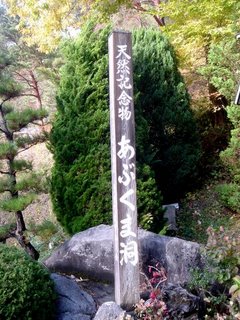At my traveling in Tohoku area, Yamadera in Yamagata prefecture was one of my important places to visit.
Tohoku area has four famous Buddhist temples, and one of them is the Yamadera, So I’ve watched some posters of it at some JR stations. So I ‘m so happy! Because, I got the opportunity to visit the great temple, and I also get the opportunity to upload some my pictures about Yamadera!
I hope that my picture will make you visit the temple.

There are some reasons that Yamadera is famous, and one of them is Basho Matsuo who is one of the greats about Haiku that is Japanese poem. There is his bronze statue near the souvenir shops the foot of the mountain.
Then, if you see the next of the bronze statue, you would find the monument about his poem.

The poem describe below means.
Silent
Soaking into the rock
The chirring of cicadas
My last boss sometimes gave me the explanation about this Haiku. The time he told me that there are a lot of cicadas and they are chirring in chorus in summer, the time Basho found the fact that he can’t hear it. It just likes that the chirring are soaking in the rock.

This is the gate of Yamadera. At the gate we need to pay 300 Yen to enter. I think it’s so cheap if I compare to the famous temples in Kyoto, and the price is the cheapest.
At inside of the temple, we can find some interesting things, and the below is also one of them.

Somebody put a lot of coins into in the cracks of the bark of the big tree.
Some of senior Japanese believe that big trees have a sprits or god. I guess that they might do it.
If I visited there with one of my Chinese friends who really love Ninja, I would say “They are present Shuriken and they are very safety, Because, it isn’t dangerous, is it?” to him.

We found some sculptures on the big rock after few minutes ago. The mountain is a big rock mountain and it has a lot of sculptures and small shrines. The picture is just one of them.

Than, if we saw left side, there is a gate. It isn’t the top of the mountain.

On the other hands, if we saw right side, there are some small shrines on the rock. Can you see some stone images of Jizo? I felt some spirits of the Buddhist monks who leads an ascetic life on the mountain that was the holy mountain for them before. And a lot of monks died here.

And this is the picture that I took after the gate. The view is so beautiful by the temple and the rocks and autumn leaves.

After few minutes, I took this picture. It was almost the top of the mountain. There are three roads to go the top, to go the foot of the mountain and to go the right side of the picture. There is a monumental image of Buddha at the top, but we couldn’t see it at that time.

Can you see a lot of the shrines on the picture? At last junction, I went to right road and took this. Of cause we can’t go there, the reason is so dangerous for general people.
But autumn leaves are so nice.

There is a kind of turret at the end of the road, and we can enjoy the great view on the turret. At that day, I climbed the mountain from the foot, but we didn’t feel tired. I can guess the reason that the mountain is so interesting and we enjoyed convocations during climbing. Especially, this season is one of the best to visit there by autumn leaves.

On the turret, I took the picture. I think that this picture is so easy to guess the feature of the part of the mountain. Can you guess how the monks lived in the small hut on the right side of the picture? I have no idea.

When I went down the mountain, I took it. At this mountain I sometimes felt that maple is the best of autumn leaves. I really love deep red maples, and it adds a good accent for the beautiful view.
Finally, I want to describe that my impression of Yamadera.
I really want to recommend to visit the temple. Because, the temple owns a mountain and the site is so vast comparing to some temples in Kyoto. And you might enjoy a lot of refined views.
If I say one fault, the temple is so far from some big city in Japan. So it’s better to go there by the cars.
This time, I visited there in autumn. I can easily guess that there would be some difference tastes in other seasons, which are summer and winter.





















































